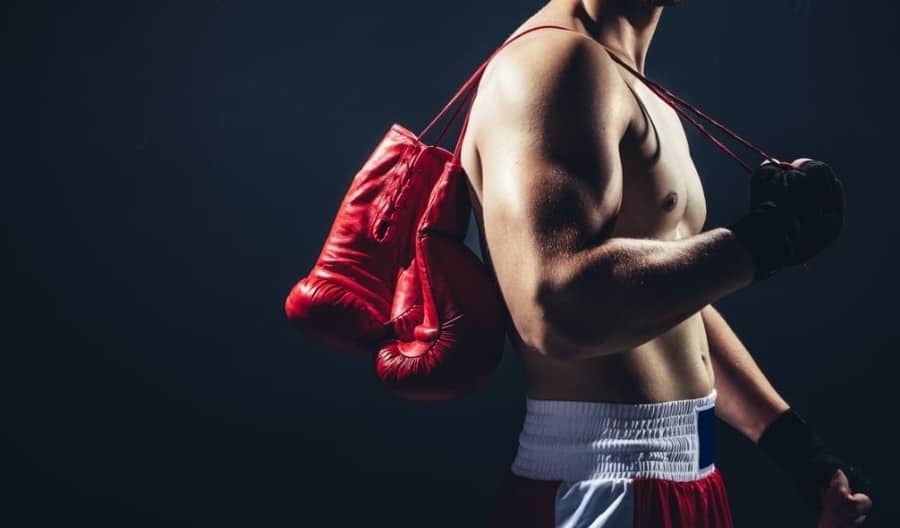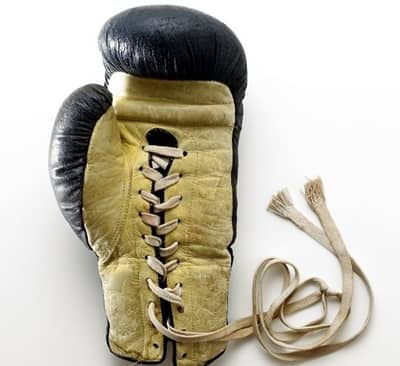
Looking for the right pair of gloves when you’re a newbie to boxing or kickboxing can be pretty overwhelming. There are so many different sizes, shapes, and colors to choose from. But more importantly, what you really need to know is what type of glove is best for the training you are doing. Boxing gloves and kickboxing gloves are often pigeonholed into the same big category of “gloves” by those who just don’t know better. But the two are very different in many ways, and these differences play an important role deciding which are best for your training objectives.
The difference between boxing gloves and kickboxing gloves comes down to a few key factors. Boxing gloves have more padding in the knuckle area, a more rigid structure and rounded shape, and an attached thumb. In contrast, kickboxing gloves have more distributed padding on the back and side of the hand, and a detached thumb for added flexibility.
All of this being said, the distinctions between these gloves are there for very specific purposes. Let’s take a look at each glove characteristic, what they are designed to do, and how they’ll benefit you.
| Boxing Glove | Kickboxing Glove | |
| Padding | Most padding in the knuckle/thumb | Padding distributed throughout the glove |
| Structure and shape | Rounded, attached curved thumb | More square, detached thumb |
| Flexibility | Inflexible | More flexible |
| Closure | Hook and loop (Velcro) or lace-up | Hook and loop most common |
Padding
Boxing Gloves
The bulk of the padding in a boxing glove will be in the knuckle area. Because boxing is geared almost entirely toward punching, it is imperative that these gloves provide ample cushion in the knuckles to avoid hand injuries.
The cushion in these gloves will also help to protect a fighter’s sparring partner from a blow to the jaw, nose, or ribs. For this reason, competitive boxers will almost always have at least two types of gloves. One pair will provide extra padding for sparring. The other pair will be more rigid and lighter weight (lighter weight equals less padding) for matches since the ultimate goal in the ring is to bring the opponent to the floor.
This is why there are strict boxing glove guidelines in a match. All boxers must wear 10oz gloves in armature and professional boxing. Without this rule, competitors would opt to use even lighter weight gloves with less padding in order to do more damage to their opponent.
Kickboxing Gloves
Because kickboxing makes use of many different striking techniques using the hands, feet, knees, and elbows, kickboxing is much less focused on punching than boxing. Less focus on punching requires less padding in the knuckle area than the boxing glove provides.
Instead, the padding in a kickboxing glove is distributed uniformly around the knuckle, and the back and side of the hand. Kickboxers will often use the back and sides of their hands for different types of strikes, holds, and blocks, so the extra cushion in these key areas help to protect the other parts of the hand as well.
Structure and Shape
Boxing Gloves
Since boxing gloves are designed with extra padding in the knuckle area, they will have a more rounded look to them. Some will have a mesh area in the palm of the hand for added breathability. The padded thumb of the boxing glove will always be attached and tucked inward toward the glove to contribute more protection to the thumb. This design is again aimed at insulating the boxer’s knuckles and thumb as much as possible.
Kickboxing Glove
With less padding around the knuckles, kickboxing gloves are noticeably more square and boxy than boxing gloves. Some kickboxing gloves will also have a longer, more padded enclosure for extra wrist support. The thumb portion of the glove will typically be straighter, rather than tucked in.
The thumb piece is typically “detached” from the rest of the glove. This doesn’t mean that the thumb is completely unattached to the glove. Normally it will be attached to a strip of leather/vinyl that is then attached to the glove. This allows the fighter to have to have the ability to more freely open and close the hand, which is essential in kickboxing techniques such as catches and clinching.
Flexibility
Boxing Gloves
Since the boxing glove is highly padded around the knuckles and thumb, the glove overall is very inflexible. You will not be able to open or close your hand at all in a boxing glove. The extra padding and inflexibility also contributes more stability and support in the hand, which again is important for a boxer who’s throwing punch after punch.
Kickboxing Gloves
Kickboxing gloves will be more firm in the knuckle area than boxing gloves because the padding is distributed throughout the glove, rather than being primarily at the knuckles. But although they are more firm, kickboxing gloves are also more flexible overall to allow for more hand movement. Kickboxers need to be able to open their hands to catch kicks and perform certain strikes, so this flexibility is necessary in the ring.
Velcro or Lace-up Closure

Boxing Glove
There are two choices when it comes to boxing glove closures: hook and loop and lace up. Hook and loop (also known as Velcro) is the most convenient. These gloves are quick and easy to put on and take off without any help.
The hook and loop is the most common type of closure, and also the one most boxers will use when training. The drawback of the hook and loop closure is that they won’t fit as securely as a lace up glove. But having an extremely tight, secure fit when you are punching the bag is not really necessary. It does become necessary to have this extra fitted glove when you have a heavy sparring session or you are competing. Nobody wants to worry about a glove flying off of your hand when you’re in the middle of a match.
Most serious boxers will have at least two pairs of gloves specifically designed for training and matches. Lace up gloves take a little extra time to put on, and will require some assistance, but they are an essential piece of gear if you will be spending any time in the ring.
Kickboxing Gloves
Kickboxing gloves most commonly come with a hook and loop closure. It is quite rare to find a pair of lace up kickboxing gloves- but they are out there. Since kickboxers use more than just their hands in their matches, it’s not as crucial for their gloves to be laced up like those of a boxer. Most likely, as a competitive kickboxer, you will have at least two pairs of gloves; one for competition and one for training, but in all likelihood both will have a hook and loop closure.
Now that we’ve nailed the key differences between these two types of gloves, you might be surprised to discover that you really shouldn’t use kickboxing gloves for most kickboxing training!
What Gloves Should I Get For Kickboxing
So after all this talk about the differences between boxing gloves and kickboxing gloves, you’re probably thinking you should go out and get yourself some kickboxing gloves if you are taking kickboxing classes. Wrong! This really couldn’t be further from the truth.
Yes, kickboxing gloves are quite different from boxing gloves, and if you are competing you definitely should own a pair of kickboxing gloves. BUT, if you are not training to compete, you should not be using kickboxing gloves. A pair of 14-16 oz. boxing gloves are hands down, the absolute best glove for cardio kickboxing, kickboxing training on the punching bag, and even for some sparring.
Some may disagree, so let me explain. If you are punching a heavy bag a few times a week, that repetitive impact can be really hard on your joints over time. It might not seem like a big deal when you’re young, but you will start to feel it in your wrist and shoulders as time goes on.
One of the best ways to avoid injury to your joints is to use heavier boxing gloves, which have a lot more of padding in the knuckles and thumb. All of this padding will reduce the stress that you put on your joints. The heavier weight of the glove also requires more muscle engagement when punching, and therefore will help build strength and endurance.
Another benefit to using a heavy boxing glove for kickboxing is that you will reduce the chance of injuring your sparring partner. Kickboxing gloves are firmer, and being struck by one tends to hurt more than a much softer, padded boxing glove. Of course, if you are sparring to prepare for a match, this doesn’t apply. You will want to train with actual kickboxing gloves in order to be fully adjusted to the gloves and moves you will use in the ring.
Do You Really Need Gloves For Kickboxing
If you have never taken a kickboxing class, you are probably wondering what kind of equipment you will need and if you will need to buy some gloves for your class. You will absolutely need gloves for kickboxing if you will actually be punching a bag, or an opponent. You do not need gloves for fitness kickboxing if your class does not involve hitting a punching bag.
So it is important to ask the gym if the class uses punching bags, and if they provide gloves. If they are using punching bags and they don’t supply gloves, or even if they do, take a look at the gloves I use here on my recommended gear page. There are some really good options there that won’t break the bank, but will make a huge difference in your comfort and safety in your kickboxing class.
If you aren’t using a bag and are instead throwing punches and kicks in the air, take a look at these weighted gloves. They’re great for building strength and endurance. You can also use them when you’re walking or doing other forms of cardio to give your workout a boost.
What Oz. Gloves Should You Use For Kickboxing
Kickboxing and boxing gloves come in weights between 6-18 ounces. The 6-8 oz gloves are normally only used by youth. Glove weight really refers to the amount of padding in the glove. The lower the weight, the less cushion they will have.
Competitive boxers use 10 oz gloves in matches. But there is not a standard weight glove for kickboxing. Fighters will want to use the lowest weight possible with the least amount of padding to get the hardest hits in when they’re in the ring.
But if you’re not competing, you will want to use a 14-16 ounce boxing glove for all of your training and workouts. The higher weight gloves will protect your joints from repetitive use injuries and give you a more intense workout. To learn more about why 14-16 ounce boxing gloves are best for kickboxing training, and how you can get those most out of your workouts, check out this article that will give you all the information you need to choose a pair of gloves.
Are MMA Gloves Different From Kickboxing Gloves?

Although kickboxing is actually a type of Mixed Martial Art (MMA), the two have each come to be known as very different sports. MMA is defined as any fighting style that combines techniques from more than one martial art, which is what kickboxing is by definition. But the type of kickboxing generally known in the United States differs quite a bit in style, rules, and regulations from what is recognized as MMA.
In American kickboxing any strikes below the belt, throwing, or grappling are off limits, while in contrast MMA does permit all three of these moves. MMA is thought to be a more aggressive sport when compared with kickboxing.
For these reasons, the gloves worn in MMA and kickboxing are different. Kickboxing gloves are padded throughout and have an enclosed thumb and fingers. Since kickboxers use more boxing based punches than MMA, more padding and protection is required. MMA gloves are fingerless and much thinner than kickboxing gloves.
Safety is not a big focus in MMA and the fighters go all out in a match. Because MMA is notoriously a more brutal sport than kickboxing, thin, unpadded gloves are used to increase the potential for a more devastating blow to their opponent. MMA gloves also need to be thinner in order to have full use of the hands for takedowns, throws, and grappling.
As you can see, there are many variations of gloves out there, each with their own purpose. For kickboxing, choose a pair of 14-16 oz boxing gloves to get the most protection possible, so that you can continue to punch and kick for years to come!
